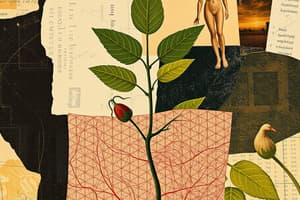Podcast
Questions and Answers
What is the primary function of leaves in plants?
What is the primary function of leaves in plants?
- Water storage
- Photosynthesis (correct)
- Nutrient absorption
- Soil anchorage
Which branch of botany focuses on the classification and naming of plants?
Which branch of botany focuses on the classification and naming of plants?
- Plant Physiology
- Plant Taxonomy (correct)
- Plant Anatomy
- Plant Morphology
Which hormone is primarily responsible for promoting cell division in plants?
Which hormone is primarily responsible for promoting cell division in plants?
- Auxins
- Gibberellins
- Cytokinins (correct)
- Abscisic Acid
What is the main process through which plants convert light energy into chemical energy?
What is the main process through which plants convert light energy into chemical energy?
What type of roots are characterized by a main central root with smaller lateral roots?
What type of roots are characterized by a main central root with smaller lateral roots?
In which group are plants that produce seeds within fruits categorized?
In which group are plants that produce seeds within fruits categorized?
Which factor does NOT typically affect plant growth?
Which factor does NOT typically affect plant growth?
Which method of plant reproduction involves the use of flowers and seeds?
Which method of plant reproduction involves the use of flowers and seeds?
Flashcards are hidden until you start studying
Study Notes
Overview of Botany
- Definition: Botany is the scientific study of plants, including their structure, properties, and biochemical processes.
- Branches:
- Plant Physiology: Study of plant functions and processes.
- Plant Ecology: Examines plant interactions with environments and ecosystems.
- Plant Taxonomy: Classification and naming of plants.
- Plant Anatomy: Structure and organization of plant cells and tissues.
- Plant Morphology: Study of plant form and structure.
Plant Structure
- Roots: Anchor plants, absorb water and nutrients.
- Types: Taproots, fibrous roots.
- Stems: Support above-ground structures and transport nutrients.
- Types: Herbaceous, woody stems.
- Leaves: Main site for photosynthesis; exchange gases (stomata).
- Types: Simple, compound leaves.
Photosynthesis
- Process: Conversion of light energy into chemical energy.
- Occurs in chloroplasts.
- Equation: 6CO2 + 6H2O + light energy → C6H12O6 + 6O2.
- Importance: Produces oxygen, food for plants, and forms the basis of food chains.
Plant Reproduction
- Methods:
- Asexual: Cloning through cuttings, runners, tubers.
- Sexual: Involves flowers and seeds.
- Fertilization: Fusion of male and female gametes (pollen and ovule).
- Seed Dispersal: Mechanisms include wind, water, animals.
Plant Growth
- Factors Affecting Growth:
- Light, water, temperature, soil nutrients.
- Hormones:
- Auxins: Stimulate growth.
- Gibberellins: Promote stem elongation.
- Cytokinins: Promote cell division.
- Abscisic Acid: Inhibits growth, promotes dormancy.
Plant Adaptations
- Desert Plants: Thick cuticles, water storage (succulents).
- Aquatic Plants: Flexible stems, floating leaves.
- Tropical Plants: Large leaves for light capture, high biodiversity.
Importance of Botany
- Ecological Role: Fundamental for ecosystems, carbon sinks, oxygen producers.
- Agriculture: Basis for crop production and improvement.
- Medicinal Uses: Source for pharmaceuticals and natural remedies.
- Conservation: Protects biodiversity and plant species.
Classification of Plants
- Two Main Groups:
- Non-vascular: Mosses and liverworts (bryophytes).
- Vascular: Seedless (ferns) and seed plants (gymnosperms and angiosperms).
- Gymnosperms: Seed plants without flowers (e.g., conifers).
- Angiosperms: Flowering plants, produce seeds within fruit.
Key Terms
- Chlorophyll: Green pigment essential for photosynthesis.
- Xylem: Tissue that transports water and minerals.
- Phloem: Tissue that transports sugars and organic compounds.
- Mycorrhizae: Symbiotic association between fungi and plant roots for nutrient exchange.
Current Trends in Botany
- Plant Genetics: Genomic studies to enhance crop resistance.
- Sustainable Practices: Focus on preserving biodiversity and ecosystem health.
- Urban Botany: Integration of plants into urban settings for ecological benefits.
These notes provide a concise overview suitable for a foundational understanding of botany and its various aspects.
Botany: The Study of Plants
- Botany investigates the structure, properties, and processes of plants.
Branches of Botany
- Plant Physiology: Examines the functions and processes within plants, like photosynthesis and respiration.
- Plant Ecology: Explores how plants interact with their environments and within ecosystems.
- Plant Taxonomy: Focuses on classifying and naming plant species.
- Plant Anatomy: Studies the internal structure and organization of plant cells and tissues.
- Plant Morphology: Analyzes the external form and structure of plants, like leaf shapes and root systems.
Plant Structure
- Roots: Anchor plants to the ground and absorb water and nutrients.
- Taproots: Single, large root with smaller lateral roots.
- Fibrous roots: Network of thin roots.
- Stems: Provide support for above-ground structures and transport nutrients.
- Herbaceous stems: Soft and green.
- Woody stems: Hard and thick.
- Leaves: Primarily responsible for photosynthesis and gas exchange through stomata.
- Simple leaves: Single, undivided blade.
- Compound leaves: Multiple leaflets attached to a common stalk.
Photosynthesis: The Process of Life
- Photosynthesis converts light energy into chemical energy, stored as sugars.
- Takes place within chloroplasts, which contain chlorophyll, a green pigment that absorbs light energy.
- Equation: 6CO2 + 6H2O + light energy → C6H12O6 + 6O2
- Importance: Produces oxygen, provides food for plants, and forms the foundation of food chains.
Plant Reproduction
- Asexual Reproduction: Creates clones of the parent plant through methods like cuttings, runners, and tubers.
- Sexual Reproduction: Involves flowers and seeds.
- Fertilization: Fusion of male and female gametes (pollen and ovule).
- Seed Dispersal: Uses mechanisms like wind, water, and animals to spread seeds.
Plant Growth
- Factors Affecting Growth:
- Light: Needed for photosynthesis.
- Water: Essential for cell functions and transport.
- Temperature: Influences metabolic rates.
- Soil Nutrients: Provide essential elements for growth and development.
- Hormones: Regulate plant growth and development.
- Auxins: Stimulate cell elongation and growth.
- Gibberellins: Promote stem elongation.
- Cytokinins: Promote cell division and growth.
- Abscisic Acid: Inhibits growth and promotes dormancy.
Plant Adaptations
- Desert Plants:
- Thick cuticles to reduce water loss.
- Water storage tissues (succulents).
- Aquatic Plants:
- Flexible stems for movement in water.
- Floating leaves for sunlight absorption.
- Tropical Plants:
- Large leaves for capturing sunlight.
- High biodiversity due to favorable conditions.
The Importance of Botany
- Ecological Role: Plants are foundational to ecosystems, serving as carbon sinks and oxygen producers.
- Agriculture: Basis for crop production and improvement through selective breeding and genetic modification.
- Medicinal Uses: Source for pharmaceuticals and natural remedies.
- Conservation: Protects biodiversity and plant species threatened by habitat loss and climate change.
Classification of Plants: A Hierarchical System
- Two Main Groups:
- Non-vascular plants: Lack specialized vascular tissues for water and nutrient transport (e.g., mosses and liverworts)
- Vascular plants: Possess vascular tissues, allowing for more efficient transport of water and nutrients.
- Seedless vascular plants: Include ferns and horsetails that reproduce through spores.
- Seed plants: Reproduce using seeds.
- Gymnosperms: Seed plants that do not produce flowers (e.g., conifers).
- Angiosperms: Flowering plants that produce seeds enclosed within fruits.
Key Terms in Botany
- Chlorophyll: Green pigment found in chloroplasts, essential for photosynthesis.
- Xylem: Vascular tissue that transports water and minerals from roots to other parts of the plant.
- Phloem: Vascular tissue that transports sugars and other organic compounds throughout the plant.
- Mycorrhizae: Symbiotic association between fungi and plant roots, enhancing nutrient uptake for both organisms.
Current Trends in Botany
- Plant Genetics: Research focuses on utilizing genomic information to enhance crop resistance to pests, diseases, and environmental stresses.
- Sustainable Practices: Emphasizing the importance of protecting biodiversity and ecosystem health for future generations.
- Urban Botany: Integrating plants into urban environments for ecological benefits, improving air quality and aesthetics.
Studying That Suits You
Use AI to generate personalized quizzes and flashcards to suit your learning preferences.





